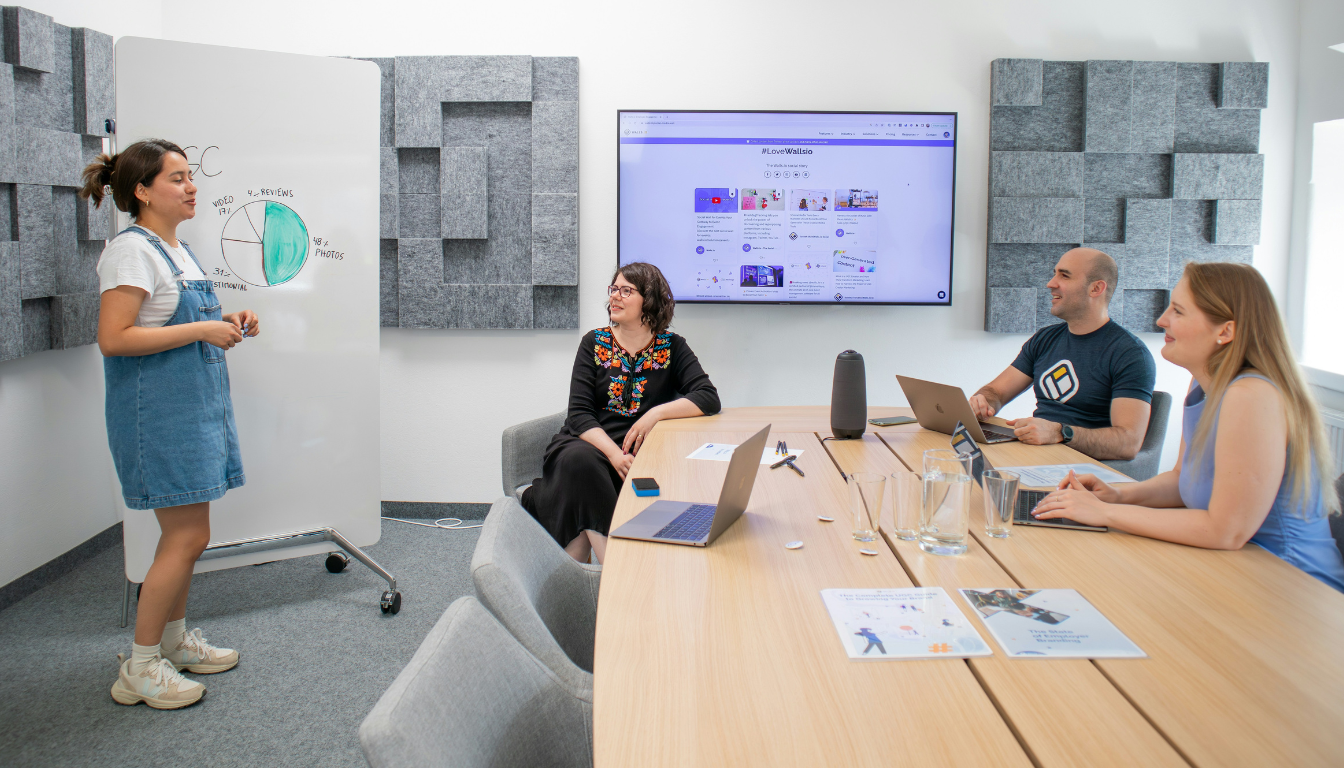Mastering Company Culture Communication: Strategies for Success

Effective company culture communication is essential for a connected and motivated workforce. This article explains why it’s important and offers practical strategies to improve how your organization communicates its culture.
Key Takeaways
- Effective company culture communication significantly enhances employee engagement, motivation, and overall organizational success, emphasizing the importance of transparency, regular updates, and psychological safety.
- Leadership plays a crucial role in shaping a strong communication culture through active listening, providing constructive feedback, and modeling desired behaviors, fostering trust and alignment with organizational goals.
- Improving internal communication requires leveraging modern tools, encouraging two-way communication, and tailoring messages to meet audience needs, which is essential for enhancing employee satisfaction and productivity.
Understanding Company Culture Communication

Company culture communication is the lifeblood of any organization. It encompasses the shared practices and values that dictate how employees and managers engage with one another. Effective communication is central to organizational success, influencing employee experience, motivation, and overall culture and business growth. Communication on workplace culture is essential for fostering a positive environment.
A positive communication culture not only encourages employees to share ideas and collaborate but also fosters alignment with the organization’s shared purpose and values, ultimately enhancing loyalty and engagement. Communication in corporate culture plays a critical role in shaping how teams connect, collaborate, and perform.
The Impact of Effective Communication on Company Culture

Effective communication significantly influences company culture. Its impact is essential and should not be underestimated. A strong communication culture enhances clarity, cooperation, and trust among employees, leading to higher engagement and alignment with organizational goals. When communication breaks down, it can result in decreased employee retention rates and lower productivity. To effectively communicate culture, organizations must prioritize strong communication practices, including facilitated offsite gatherings such as those supported by Offsite, which offer structured settings to reinforce cultural values and strategic messaging.
Conversely, organizations that prioritize internal communication often see significant improvements in employee engagement and retention. The importance of internal communication is evident, as effective communication drives business growth and also drives innovation and knowledge sharing, giving organizations a competitive edge and fostering business resilience and continuity.
Key Components of Strong Communication Culture
Building a robust communication culture involves several key components: transparency and openness, regular updates and feedback, and psychological safety. Transparency fosters accountability and strengthens core values within the organization. Regular updates keep employees informed and engaged, while feedback loops ensure communication strategies remain relevant and effective.
Psychological safety allows employees to freely voice suggestions and concerns, promoting a culture of openness and mutual trust. Together, these elements create a positive communication culture that drives business growth and employee satisfaction.
Transparency and Openness
Transparency and openness are the cornerstones of a positive communication culture. By being transparent and admitting mistakes, organizations create an environment of trust and accountability. Open communication encourages employees to voice concerns, fostering mutual trust and stronger relationships within the workplace.
Sharing objectives and key results (OKRs) promotes openness, aligns everyone, and clarifies roles within the organization. This transformation from need-to-know communication to open dialogue significantly enhances employee engagement and satisfaction.
Regular Updates and Feedback
Regular updates and feedback are essential for maintaining strong communication within an organization. Leaders should engage in regular communication to help employees stay connected and understand their roles. Collecting feedback regularly is crucial for improving communication strategies to be more effective and responsive to employee needs.
Adjusting these strategies based on ongoing feedback ensures they remain relevant and effective, ultimately leading to better communication and higher employee satisfaction.
Psychological Safety
Creating an atmosphere of psychological safety is critical for fostering employee engagement and a culture of openness within the organization. Psychological safety allows employees to freely welcome suggestions and feedback during meetings. Understanding individual employee preferences for communication methods can lead to more effective interactions and contribute to a safe environment.
Providing multilingual tools in communication platforms helps engage a diverse workforce, enhancing inclusivity. Effective use of body language and active listening by managers further reinforces this safe and supportive environment.
Strategies to Improve Internal Communication

Improving internal communication requires a multifaceted approach that includes leveraging modern communication tools, encouraging two-way communication, and tailoring messages to the audience. Investing in modern communication tools ensures seamless and efficient information flow within teams, especially in remote work settings, to make your internal communications more effective and enhance communication processes. Additionally, an internal communications white paper can provide valuable insights into best practices and an internal communication strategy.
Encouraging two-way communication eliminates one-way communication barriers and promotes an open dialogue where employees feel heard and valued. Tailoring formal and informal communication in the workplace to fit the audience’s needs fosters a supportive and engaged workplace, ensuring that messages resonate effectively with employees.
Leverage Modern Communication Tools
Modern communication tools are pivotal in improving internal communication and internal communications. Utilizing platforms like intranets, instant messaging, and video conferencing can centralize information sharing and enhance engagement among employees. Tools like Slack and Zoom facilitate real-time interactions and project management, making them essential for remote work environments. Additionally, effective internal communication on workplace dynamics is crucial for fostering a collaborative atmosphere.
Investing in these tools ensures that communication remains efficient and effective, regardless of physical location, thereby fostering a positive communication culture.
Encourage Two-Way Communication
Encouraging two-way communication is essential for fostering a positive communication culture. Employees are more likely to feel empowered and engaged when their voices are heard. Leaders can promote engagement by eliminating one-way communication and inviting team members to share their ideas, ask questions, and provide feedback.
Regular employee surveys and suggestion boxes can also be used to collect anonymous feedback, providing valuable insights into the effectiveness of internal communication strategies.
Tailor Communication to Audience Needs
Tailoring communication to audience needs is crucial for ensuring messages resonate effectively with employees. Personalized and relevant communication approaches help meet employee needs and foster an inclusive environment. Encouraging workers to share their concerns and preferences for communication methods can lead to more effective interactions and higher engagement.
By understanding and addressing the unique needs of their audience, organizations can establish workplace culture goals to create a more supportive and engaged workplace.
Leadership's Role in Shaping Communication Culture

Leadership plays a crucial role in shaping and maintaining a strong communication culture within an organization. Effective leaders model desired behaviors, practice active listening, and provide constructive feedback, all of which contribute to a positive communication culture.
Regular and authentic communication from leaders reinforces the company’s values and goals, fostering employee engagement and alignment with business objectives.
By creating an open-door policy and actively involving employees in the communication process, leaders can significantly enhance the overall communication culture.
Leading by Example
Leading by example is a powerful way for leaders to influence their teams and reinforce the values of their organization, ensuring that their actions are aligned with the values of their organization. When leaders consistently exemplify the behaviors they expect from others, it reinforces and amplifies a strong organizational culture throughout the company.
Regular one-on-one meetings with managers significantly increase employee engagement, making them feel more connected and supported. Senior leaders should also provide regular updates on the business to enhance communication and ensure employees understand how their work contributes to the organization’s goals, ultimately to improve employee engagement.
Active Listening
Active listening is a critical skill for leaders aiming to create a supportive and positive communication culture. Leaders who practice active listening make employees feel valued and understood, fostering a sense of trust and openness.
Consistent one-on-one check-ins help managers gauge employee sentiments, clarify misunderstandings, and ensure that communication remains effective, especially in remote work settings.
Providing Constructive Feedback
Providing constructive feedback is essential for fostering employee development and maintaining a positive communication culture. Constructive feedback from leaders can significantly enhance employee engagement and satisfaction, contributing to overall organizational success.
By regularly offering feedback and recognizing employee achievements, leaders can elevate feedback and recognition to create an environment of continuous improvement and elevating feedback and recognition.
Overcoming Barriers to Effective Communication
Overcoming barriers to effective communication is crucial for maintaining a positive communication culture. Common barriers include information overload, grapevine communication, and cultural differences. Addressing these challenges requires clear communication plans, appropriate technology, and an understanding of diverse communication styles.
Organizations that prioritize clear communication and inclusivity see improvements in employee retention and a host of organizational outcomes including profit retention.
Managing Information Overload
Managing information overload is essential for ensuring employees feel informed and not overwhelmed. Many organizations struggle with inundating employees with too much information, leading to a sense of overwhelm.
Strategies to manage this business strategy include prioritizing and streamlining communication, using clear and concise messages, and ensuring that information is relevant and necessary. Additionally, implementing strategies to positively communicate can enhance overall effectiveness.
Addressing Grapevine Communication
Grapevine communication, while inevitable, can be effectively managed to prevent misinformation and rumors from spreading. Approximately 70% of organizational communication stems from grapevine channels, which most employees find trustworthy. Organizations with positive communication cultures are adept at managing grapevine communication and mitigating the impact of rumors and gossip.
Proactive management and fostering open communication can help reward good communication practices and address grapevine communication effectively.
Bridging Cultural Differences
Bridging cultural differences is essential for creating an inclusive and effective communication culture. Developing strong cross-cultural communication skills helps in understanding diverse communication styles and promoting inclusivity. Active listening, asking questions, and fostering meaningful interactions within diverse teams can significantly enhance team dynamics and collaboration.
Encouraging open conversations and trying new methods can improve cross-cultural communication and understanding.
Enhancing Remote Team Communication

Enhancing how remote teams communicate is critical in today’s increasingly remote work environment. Organizations can struggle to build and manage communication cultures that keep remote employees connected, engaged, and inspired.
However, with the right strategies and tools, remote communication can be significantly improved, leading to a productivity boost of up to 30%. Effective remote communication strategies include leveraging digital tools, regular virtual check-ins, and fostering inclusivity.
Digital Tools for Remote Communication
Digital tools play a crucial role in facilitating remote communication. Utilizing a social intranet can centralize information sharing and enhance engagement among employees. Tools like Slack, Zoom, and mobile intranet applications facilitate real-time interactions and project management, making remote work more efficient and connected.
Investing in these tools ensures seamless communication and supports a positive remote work culture.
Regular Virtual Check-Ins
Regular virtual check-ins are essential for maintaining alignment and engagement within remote teams. Scheduled virtual meetings help employees remain aligned with company values and objectives, ensuring that everyone is on the same page and feels connected to the organization.
These check-ins also provide opportunities for feedback and address any concerns, fostering a supportive remote work environment.
Fostering Inclusivity in Remote Settings
Creating an inclusive remote environment involves ensuring that all employees have opportunities to contribute and feel heard. This can be achieved by actively involving remote employees in discussions, providing equal access to resources, and encouraging diverse perspectives.
Inclusive practices not only enhance employee engagement but also help to reflect your workplace culture in remote settings, ensuring that remote workers feel connected and valued.
Measuring the Effectiveness of Your Communication Strategy
Measuring the effectiveness of your communication strategy is crucial for continuous improvement and alignment with organizational goals. Regularly evaluating communication strategies helps identify areas for improvement and ensures that they resonate with employees’ needs.
Effective communication fosters employee engagement, creating a sense of belonging and purpose, thereby increasing overall job satisfaction and organizational success.
Employee Surveys and Feedback
Employee surveys and feedback mechanisms are essential for understanding employee satisfaction with communication practices. Anonymity in surveys encourages truthful feedback, which is crucial for identifying areas for improvement in internal communication.
Utilizing feedback gathered through anonymous surveys can significantly enhance the effectiveness of internal communication practices, leading to a more engaged and satisfied workforce, as highlighted by Gallup Workhuman.
Analyzing Communication Metrics
Analyzing communication metrics is vital for assessing the reach and impact of internal communication strategies. Tracking metrics such as response rates, engagement levels, and email open rates provides insights into the success of communication initiatives.
Utilizing a mix of quantitative and qualitative metrics helps organizations measure the effectiveness of their communication efforts and identify areas for growth.
Continuous Improvement
Continuous improvement is essential for maintaining a dynamic and effective communication culture. Feedback mechanisms and key metrics provide valuable insights into the strengths and weaknesses of communication strategies. By analyzing these insights, organizations can refine their strategies and ensure alignment with organizational objectives, leading to increased employee satisfaction and overall business success.
Summary
Mastering company culture communication is a multifaceted endeavor that requires a strategic approach to fostering transparency, regular updates, psychological safety, and leveraging modern tools. Effective communication enhances employee engagement, satisfaction, and productivity, driving overall business success. Leaders play a crucial role in shaping communication culture by modeling desired behaviors, practicing active listening, and providing constructive feedback. Overcoming barriers to communication, such as information overload and cultural differences, and continuously measuring and improving communication strategies are essential steps in this journey. Facilitated sessions and structured retreats—such as those organized through Offsite—can serve as effective platforms for reinforcing communication values and aligning teams around shared cultural goals. By implementing these strategies, organizations can create a vibrant and inclusive communication culture that drives growth and success.
FAQs
- What is company culture communication?
Company culture communication involves the shared practices and values that shape employee and management interactions, ultimately impacting organizational success. Prioritizing effective communication of these cultural elements fosters a positive working environment and enhances collaboration.
- How does effective communication impact company culture?
Effective communication cultivates an environment of clarity and trust, which significantly boosts employee engagement and productivity. This ultimately contributes to a positive and thriving company culture.
- What are the key components of a strong communication culture?
A strong communication culture relies on transparency, regular updates and feedback, and psychological safety, fostering a positive and open environment for all. These components are essential for effective collaboration and trust within any organization.
- How can organizations improve internal communication?
To enhance internal communication, organizations should utilize modern communication tools, promote two-way dialogue, and customize messages to fit the audience's needs. Implementing these strategies can lead to more effective and engaging communication within the organization.
You may also like
Unique spaces for your next offsite
Find distinctive venues for your upcoming corporate retreat.
Stay Updated with Our Insights
Get exclusive content and valuable updates directly to you.







